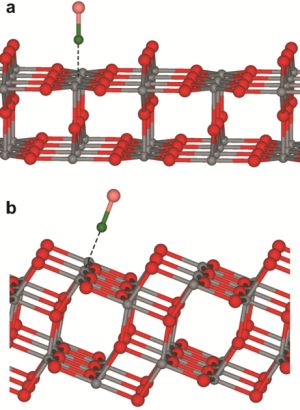An integrated international study by researchers from the University of St. Andrews (Scotland), from the University of Bochum and Helmholtz-Forschungszentrum in Berlin and the KIT Institute managed to discover new findings regarding the mechanisms underlying the photochemistry of titanium dioxide (TiO2).

Generating benefit and utilization of new energy sources are today one of the biggest challenges for humanity. Solar energy plays a central role among these sources, and the conversion of the light rays into chemical energy, for example the production of hydrogen through water splitting, is one of its interesting methods. The most common and efficient conversion process today is based on photocatalysis using titanium oxide, but it is not entirely clear in all its details. Now, thanks to the research of scientists from Germany, detailed findings have been presented regarding the basic mechanisms of this process.
Although the production of hydrogen from water and sunlight using oxides has been widely studied for several decades, the physical and chemical mechanisms of the processes involved in it still cannot be adequately described. An integrated international study by researchers from the University of St. Andrews (Scotland), from the University of Bochum and Helmholtz-Forschungszentrum in Berlin and the KIT Institute managed to discover new findings regarding the mechanisms underlying the photochemistry of titanium dioxide (TiO2).
Titanium dioxide, or titania, is a photoactive substance found in nature. When a powder of this substance, which is also used as an ingredient in dyes, dyes and sunscreens, is exposed to light, electrons undergo excitation and are able, for example, to split a water molecule into its components - oxygen and hydrogen.
The hydrogen produced by this method is a "clean" source of energy: no greenhouse gases are created that harm the climate and the only product of combustion is water. The titanium dioxide is also used in the production of self-cleaning surfaces by removing unwanted layers from them through a photochemical process initiated by sunlight. In hospitals, this ability is used to disinfect special instruments coated with the titanium dioxide layer following the irradiation of ultraviolet light.
Until today, the physical mechanisms of these photochemical reactions could not be explained by titania surfaces. The powder particles used to initiate photochemical processes are only a few nanometers in size and are therefore too small to be studied by the usual powerful methods of surface testing. Through the use of a millimeter-sized single-crystal material, the researchers were able, for the first time ever, to accurately examine the photochemical processes occurring on the titanium dioxide surface using an innovative infrared spectrometer. In addition, using a laser-based method, the researchers were also able to determine the lifetime of the excited electrons following the irradiation inside the titanium dioxide crystals.
According to the lead researcher (Christof Wöll), accurate information regarding these processes is of great importance: "A short life time means that the excited electrons return to their original state again and again: we were able to distinguish a certain type of short internal electric circuit. In the case of a long lifetime, the electrons remain in the excited state long enough so that they can reach the surface of the crystal and initiate the appropriate chemical processes there." The natural mineral form of titanium dioxide known as Anatase (The term on Wikipedia) is particularly suitable for the second purpose because it consists of a special electronic structure that prevents the formation of "internal electrical short circuits".
More knowledge about this property will allow researchers to further improve the shape, size and properties of anatase particles used to initiate photochemical processes. The goal is to develop photoactive materials with higher efficiency and longer lifetimes.
The spokesperson of the research institute points out that the findings obtained by the international team of researchers are of great importance regarding the production of chemical and electrical energy from sunlight, and especially regarding the improvement of the photochemical processes.

One response
By the end of the decade we will be weaned from oil